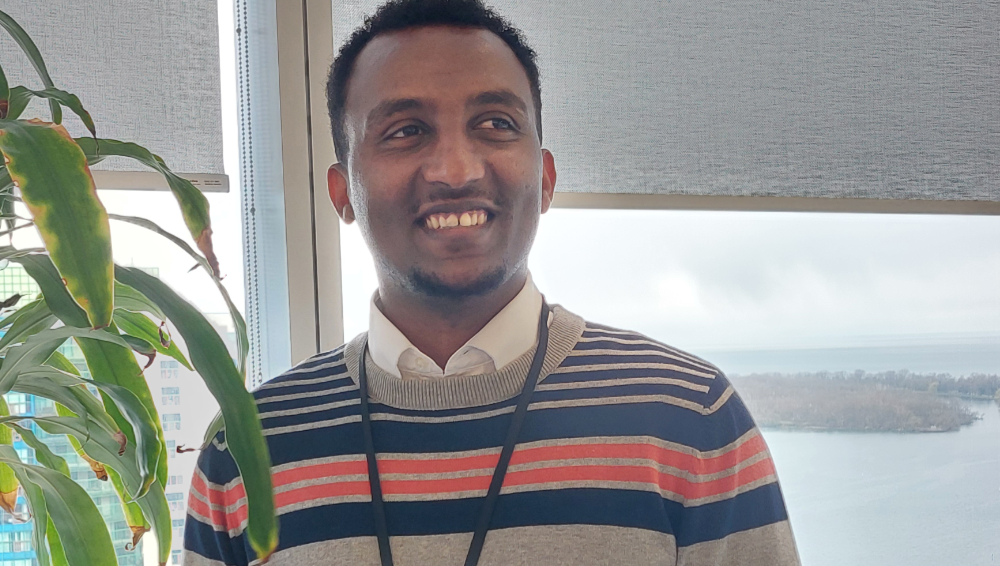


Biruk Tilahun was hired as a disability adjudicator after joining ILEO Good Jobs. | Photograph courtesy of Biruk Tilahun
Free program bridges the gap between work experience in other countries and opportunities in Canada
Biruk Tilahun, a newcomer from Ethiopia, landed a secure job in Canada just four months after joining ILEO Good Jobs, a pilot program designed to connect residents of the Greater Golden Mile with high-quality employment
. “Newcomers have different backgrounds, have different experiences. But they need opportunities,” said Tilahun, who is now working as a disability adjudicator with Sun Life of Canada, an international company that offers financial and insurance services.
“Having this opportunity is a huge thing here.” The program is one of several launched in Scarborough by the Inclusive Local Economic Opportunity Initiative (ILEO), convened by United Way Greater Toronto and BMO Financial Group. It brings together public and private partners to ensure that residents benefit from the development coming to the Greater Golden Mile neighbourhood.
Before Tilahun immigrated to Canada in 2022, he was working as a public health and project management professional for a non-profit organization in Ethiopia. A few months after he settled in the Greater Golden Mile, he applied to be part of ILEO Good Jobs, where he was able to participate in training and skills development on a module helping people become disability adjudicators at Sun Life.
Disability adjudicators review disability insurance claims and make decisions about whether people are eligible for granted benefits.
Biruk TilahunHaving this opportunity is a huge thing here.
Program connects residents with training
One of the unique aspects of the Good Jobs program is that Sun Life and an employment agency collaborated to create custom training for the disability adjudicator role.
Anita Carroll, SVP, Corporate and Stakeholder Engagement at ACCES Employment, which developed and delivered the content of the training, said the COVID-19 pandemic increased the number of disability adjudication cases Sun Life was handling. The company needed adjudicators with strong communication skills and the ability to handle stress related to the job.
Setting them up with the right training helps. The training module developed for Good Jobs familiarizes participants with medical and contract terminologies, the life cycle of disability claims, and was tailored to Sun Life’s needs. Participants also practiced recording telephone interviews to reflect the reality of the work, and reviewed case studies and scenarios to help with their decision-making.
Carroll explained that the success of the job-specific training was the result of direct conversations with Sun Life and stakeholders such as United Way Greater Toronto.
“I think that [engagement of Sun Life] really helped to align people to their values and to be onboarded,” she said. “The people that were successful had a very good understanding of the organization.”
In the second delivery training held by ACCES Employment in early 2023, 14 participants joined the project. While Sun Life initially aimed to hire five employees, nine participants eventually secured positions, according to Cameron Moser, who helped administer the training.
Tilahun has now been in the role for more than eight months. He said working as a disability adjudicator is tough, but also meaningful.
In order to succeed, adjudicators must be well organized to promptly handle each unique case and be empathetic with applicants whose claims are rejected.
The training helped immensely, he said.
The ACCES training also included modules on how to conduct a job search, resume-writing support and preparation for job interviews, all of which will serve participants throughout their careers.
Newcomers to Canada face additional barriers to finding work
Newcomers often face challenges finding meaningful work in their fields in Canada. Licensing and accreditation may be barriers.
Statistics Canada released numbers earlier this year that showed the unemployment rate for immigrants who arrived five years ago or less is 8.2 per cent. The unemployment rate for people born in Canada, on the other hand, was only five per cent.
Programs such as Good Jobs help bridge that gap. “[The project gave me] the opportunity to meet with the employer to discuss my skills and capabilities,” Tilahun said. “I’m really grateful for this opportunity because I see other friends and colleagues who are still looking for opportunities.”
Both the training related to the disability adjudicator role, and the specific job-hunting training, helped him figure out how to present himself and showcase his skills.
Tilahun explained that learning how to confidently showcase his prior achievements and what he could do through the training was effective. He described himself as a shy person, and said that cultural differences sometimes held him back.
Tilahun said that he learned from other participants with various backgrounds, including immigrants like him and neighbourhood residents, and he continues to keep in touch with them.
“I am definitely recommending everyone to take this real opportunity. Everybody’s excited about it and they ask me when will be the next,” Tilahun said.
Visit www.ileo.org to learn more about ILEO Good Jobs, including how to participate.
This story was produced as part of a partnership between Centennial College journalism students and United Way Greater Toronto.

The Centre for Inclusive Economic Opportunity, Golden Mile (CIEO) is a not-for-profit organization founded in 2020 by 10 community organizations to expand economic opportunities for residents of the Greater Golden Mile.
The ILEO Initiative brings together the private, public, and community sectors to find innovative ways to reduce gaps in economic prosperity at the neighbourhood level. ILEO is convened by United Way Greater Toronto and BMO Financial Group.